High Speed Movies - Fire, Flames and Pyrotechnics
The play of flames in a nightly campfire is captivating those who watch it, and often puts us into a thoughtful state of mind. These thoughts might also touch the nature of the phenomenon fire that we see then before us. A fire is a continous interplay between dissolution of combustible substances, their mixing with the oxygen of the air, consumption of oxygen and combustible and emission of reaction products, and the release of heat. Due to the now increased temperature, the combustion zone gains buoyancy relative to the surrounding air and drifts upwards. If the heat transferred from the flame to the fuel (wood, coal, oil) is sufficient, and enough combustible gas is evaporated, the cycle begins again, and the fire sustains itself. While the high speed videos alone can not completely evidence all of the above mentioned processes in a fire, they reveal typical patterns of several types of combustion.
Movie #1: Flames of an open wood campfire, 2009
Technical Data| Frame rate [fps] | 600 |
| Resolution [px x px] | 432 x192 |
| Viewing duration [mm:ss] | 00:16 |
| Realtime duration [s] | 0.8 |
| Filesize [kB] | 1407 |
 Download Quicktime Movie "CIMG5952_Feuer_HS600.mov"
Download Quicktime Movie "CIMG5952_Feuer_HS600.mov"Please respect the copyright of the author!
Story/Action
The wood fire is a good example for the combustion process explained in the introductory text. It relies on dissolving combustible gases from the wood by it's own heat. In the shown example, the flames stay rooted most time on a certain location on the "fuel". Still, an oscillation of the flames dissappearing and reappearing at certain locations can be observed. This is due to the periodic consumption of oxygen from the air surrounding the fire. When enough combustible gas is emitted, the fire will consume all oxygen in a certain volume. The flame can then not longer burn there, until the buoyant hot gas has drifted upwars, and is replaced by new air in it's place. Unlike for the stable flame of a candle, for a fire with a large diameter-to height ratio, the air can not flow in from sideways to all regions. Sometimes, it has to come from upwards, too. In this case, the flame can not burn continously in one root. It must "dance" with the air, coming from above and sideways. The interplay of all these dances form the complex, unpredictable phenomenon that we value so much in a campfire ...
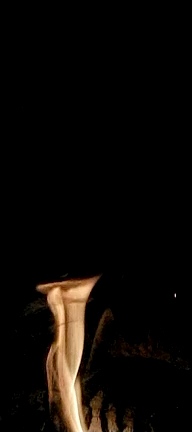 |
 |
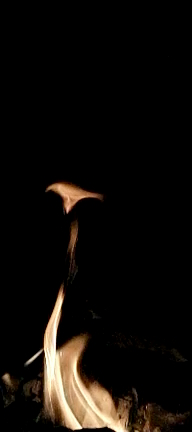 |
Movie #2: Oil torches, 2008
Technical Data| Frame rate [fps] | 600 |
| Resolution [px x px] | 432 x 192 |
| Viewing duration [mm:ss] | 00:27 |
| Realtime duration [s] | 1.35 |
| Filesize [kB] | 2566 |
 Download Quicktime Movie
"CIMG0918_Oelfackeln_HS600.mov"
Download Quicktime Movie
"CIMG0918_Oelfackeln_HS600.mov"Please respect the copyright of the author!
Story/Action
The flames from an oil surface in principle show the same behaviour as those of the wood fire. In this example, there is a strong pulsation of the flame, and typical mushroom-like shapes are created, when the heated flame, driven by it's buoyancy, shoots into the stagnant air above it.
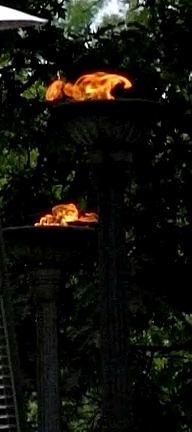 |
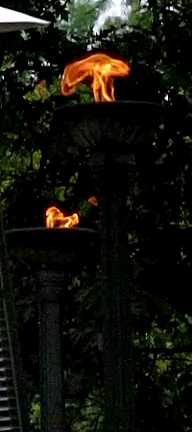 |
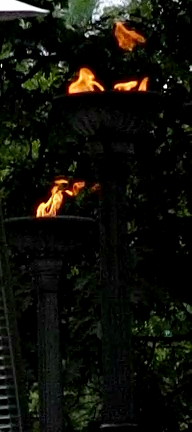 |
Movie #3: Particle injection into a gas burner flame, 2008
Technical Data| Frame rate [fps] | 1200 |
| Resolution [px x px] | 336 x 96 |
| Viewing duration [mm:ss] | 01:00 |
| Realtime duration [s] | 1.5 |
| Filesize [kB] | 2566 |
 Download Quicktime Movie "CIMG1781_Gasbrenner_TiO2_HS1200.mov"
Download Quicktime Movie "CIMG1781_Gasbrenner_TiO2_HS1200.mov"Please respect the copyright of the author!
Story/Action
In contrast to the previously shown examples, the combustion of butane gas in a bunsen burner is neither dependant on releasing the combustible gas by it's own reaction heat, nor on the mixing with oxygen inside the flame. The gas is driven by it's own pressure from the bottle, and is premixed with air before it reaches the combustion zone. The result is a stable, blue flame, which is nearly invisible in our film. This indicates, that very little soot is produced. It is the glowing of the soot particles, which render the orange colors of the previously shown flames. If the mixing orifices of the bunsen burner for the air are blocked, we get a sooting, glowing, oscillating flame with propane gas, too. On the other hand, sooting can bee prevented for oil combustion too, if it is evaporated and premixed with air before being fed into the combustion zone. In the shown high speed movie, at a certain time, titanium dioxide particles are mixed into to combustion air. Their glowing visualizes the otherwise invisible path of the hot combustion products of this flame. You can trace individual particles to see the streak lines of the buoyant flow around the burner head. The velocity of a particle travelling near the edge of the flame has been estimated by frame counting to 2.2 meters per second.
 |
 |
 |
 |
 |
Movie #4: A firecracker blows up, 2009
Technical Data (3 movies are presented)| Frame rate [fps] | 1200; 600; 300 |
| Resolution [px x px] | 336 x 96; 432 x 192; 512 x 384 |
| Viewing duration [mm:ss] | 00:13; 00:06; 00:05 |
| Realtime duration [s] | 0.325; 0.3; 0.5 |
| Filesize [kB] | 563; 616; 1228 |
 Download Quicktime Movie
"CIMG2732_Kanonenschlag_HS1200.mov"
Download Quicktime Movie
"CIMG2732_Kanonenschlag_HS1200.mov" Download Quicktime Movie
"CIMG2733_Kanonenschlag_HS600.mov"
Download Quicktime Movie
"CIMG2733_Kanonenschlag_HS600.mov" Download Quicktime Movie
"CIMG2734_Kanonenschlag_HS300.mov"
Download Quicktime Movie
"CIMG2734_Kanonenschlag_HS300.mov"Please respect the copyright of the author!
Story/Action
The explosive material in a firecracker (Kanonenschlag) contains both the combustion material and the oxygen, provided each by various chemicals. When the fuse ignites the load of the firecracker, the reaction rapidly releases hot gases, whose rising pressure breaks open the casing and purges out the glowing combustion products. The explosion goes through several phases, where the hot gases and the still reacting explosive material is ejected from the torn open casing. A fading cloud of sparks remains.
 |
 |
 |
Copyright by Frederik Arbeiter, 2008 - http://www.f-arbe.de